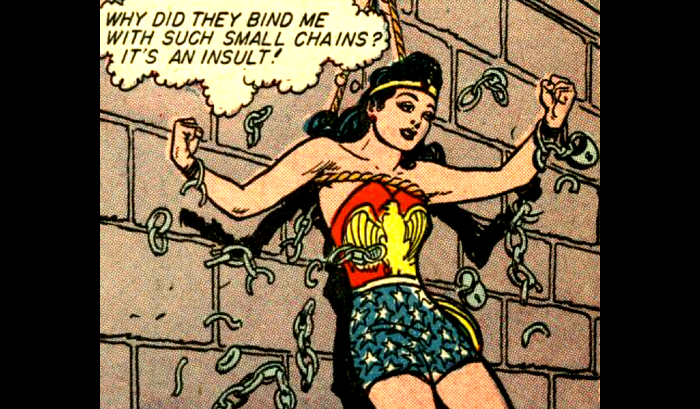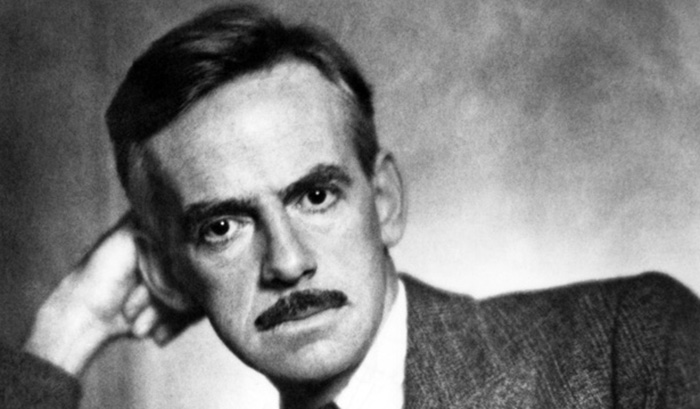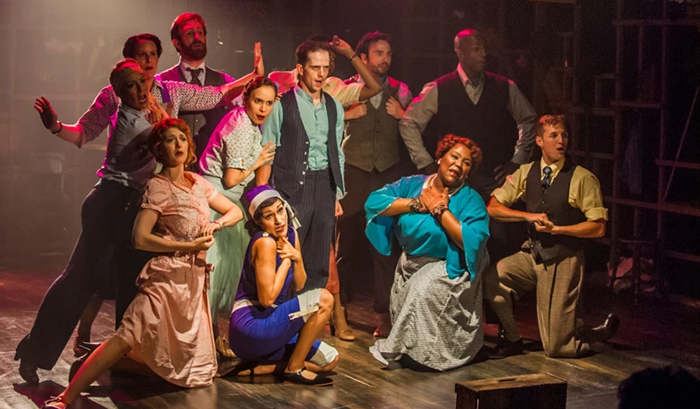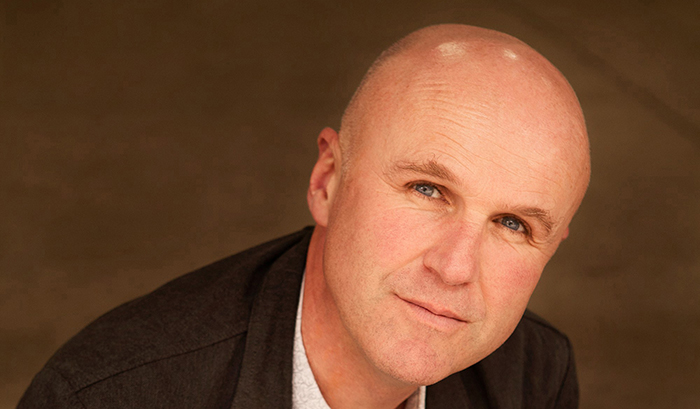
A review of Wonder Woman: Bondage and Feminism in the Marston/Peter Comics – 1941 -1948 by Noah Berlatsky.
When Warner Bros. and DC announced that Wonder Woman would make an appearance in Zack Snyder’s follow-up to Man of Steel (and precursor to a forthcoming Justice League movie), the obvious questions were: What took so long, and why is such an important and interesting character being tucked into a film about two men divided by the letter “v?”
Wonder Woman: Bondage and Feminism in the Marston/Peter Comics, 1941-1948, by culture critic Noah Berlatsky, doesn’t propose to offer insight into DC’s movie universe, but it does explore the origins of an iconic character through her creator, William Moulton Marston (who wrote under the pen name Charles Moulton.)
Berlatsky is at his most persuasive when he discusses how Marston’s ideas on gender, identity, and sexual dynamics shaped the comic. As he points out, Marston (and artist Harry Peter) used Wonder Woman to challenge the prevailing ideological foundation of comics – hypermasculine and proto-fascist – with a character not only explicitly feminist but also more conscientious about the use of force. Wonder Woman was, notably, just as liable to convert villains to her side as to forcibly subdue them.
Less persuasive are his efforts to transpose onto Wonder Woman analyses applied to other literary works, such as critic Tania Modleski’s view on gender dynamics in gothic romances. A point of contention is that Modleski’s view of gender-based power, filtered through Berlatsky’s citation, occurs in the absence of those features that define gothic romances as specifically gothic. The result is rather like discussing the Mona Lisa without mentioning her smile. If the gothic isn’t gothic because of gender dynamics – if Modleski’s analysis can be separated from other expressions of the gothic genre – then why even discuss Wonder Woman in that context? Batman is the more obvious candidate for the gothic (natch). But never mind the man who moonlights as a gargoyle on Notre Dame; as it happens, Berlatsky himself isn’t convinced by his own decision to invoke Modleski. Says he: “In the end, though, while Modleski’s analysis may make sense for the gothic romances that she studied, I think there are problems with extending it to a gothic incest story such as Wonder Woman No. 16.”
If bringing in Modleski to the discussion seems superfluous, it does at least highlight the framework that underlies Berlatsky’s own critical approach: that moldy old fossil, psychoanalysis. I would ask why literary theorists continue to interpret texts as if psychology ended with Freud, but the answer is easy: Freud offers, not scientific insight, but a giant sandbox of hidden meanings with which theorists can play, made all the more exciting by sexual anxiety. It’s what Susan Sontag condemned in her essay Against Interpretation as the “modern style of interpretation” which “excavates, and as it excavates, destroys; it digs ‘behind’ the text, to find a sub-text which is the true one. The most celebrated and influential modern doctrines, those of Marx and Freud, actually amount to elaborate systems of hermeneutics, aggressive and impious theories of interpretation. All observable phenomena are bracketed, in Freud’s phrase, as manifest content. This manifest content must be probed and pushed aside to find the true meaning – the latent content – beneath.” The old style of interpretation, by comparison, was “insistent, but respectful; it erected another meaning on top of the literal one.”
Including psychoanalysis is reasonable as a matter of historical context insofar as it influenced Marston’s own quirky psychological theories. But Berlatsky also makes psychoanalysis assume an explanatory role that abstracts topics better understood through lived experience. Whether it is Freud, Marston, or Berlatky’s book in general, we confront a sexuality that, in one movement, claims sex as a foundation while banishing sex in a simultaneous movement of symbolism. Sexuality manifests as psychological disturbances (e.g. Freudian defenses), gender dynamics, identity politics, bondage scenarios, objects (the more phallic or vaginal the better, of course), and depends on the absence of sex (it’s raison d’etre) to construct its meanings. Sexuality without sex. To be blunt: interpretation without ground. All this before pointing out that Jung, arguably more literary than Freud, did not view fundamental psychological drives in terms of sexual panic. Most importantly, psychoanalysis as a theory has long since been displaced. That theorists refuse to put it to rest in the annals of history strongly supports Sontag’s view.
With Berlatsky’s modern style of interpretation comes a measure of confirmation bias, particularly in his interpretation of panels from the comic. In this sequence, for example, we see the villainous Dr. Psycho transform an ectoplasmic projection into a multiplicity of tentacles, which he uses to bind Wonder Woman and her companions. The motion lines drawn by Peter depict the struggle between the captives and their stretchable, but not breakable, bonds.
Berlatsky sees this, but not before putting on the Freud-coloured glasses that make everything turn up penis: “…what we have here is a minister dissolving into pink ectoplasmic ropes of phallic goo and binding Wonder Woman and the entire wedding party from top to toe.”
If Marston and Peter operated within the hentai genre, where tentacle sex/rape is part of the vernacular, Berlatsky’s reading would be more convincing. The explicitness hentai is infamous for it wouldn’t even be necessary, as the image of tentacles would in-and-of-itself reference sex, however implicitly. But Wonder Woman is even less hentai than it is gothic. While Berlatsky’s reading isn’t “wrong” or “right,” it doesn’t strike me as justified.
The impression that Berlatsky is imposing his own agenda on Marston’s work is more obvious in a discussion of Wonder Woman and lesbianism. All of Chapter 3 (“Candy You Can Eat”) hinges on a debatable double-entendre that occurs in a single panel that shows us Wonder Woman teasing her overweight friend, Etta Candy:
Wonder Woman (as Diana Prince): But Etta, if you get too fat you can’t catch a man.
Etta Candy: Who wants to? When you’ve got a man, there’s nothing you can do with him…but candy you can eat!
The double-entendre comes from two panel elements: the “alignment” of a piece of candy with Wonder Woman’s crotch, and the word “candy” itself, which Berlatsky presents as specific code for female genitalia rather than the more common use as a euphemism for sex in general. From this reading, Berlatksy organizes his discussion around three critical scenarios in which the intentionality and awareness of the panel’s alleged gay subtext occurs in varying degrees for both readers and Marston/Peters.
Broadly, the problem is that his panel reading proves as unnecessary to his argument as his discussion of the gothic via Modleski was in reading Wonder Woman #16. On one level, his reading is very selective — in Wonder Woman #18, Marston’s partner Joye Murchinson wrote a boyfriend for Etta named Oscar Sweetgulper. Etta’s own sexual orientation aside, the comic’s lesbian dimension can be fairly made without over-baking the panel as Berlatsky does – or even referencing Marston’s work outside the comic (although that helps). After all, Wonder Woman comes from an all-woman island and was created by Aphrodite from magically animated clay. Berlatsky even directly discusses panels in which Wonder Woman and other Amazons role-play a game of jungle captivity whose blend of lesbianism and kink might elude young readers but is certainly visible to men and women “of the world.”

In contriving a gay subtext for a panel that doesn’t need it to serve a coherent narrative, he also misses out on a critical discussion of the panel’s literal fat-shaming. Although Marston’s portrayal of Etta Candy is sympathetic and sometimes heroic – despite her name and repeated association with boxes of chocolates or lollipops – Berlatsky’s chosen panel highlights the implicit condescension of society towards women whose body types don’t conform to the svelte ideal. An interesting discussion might have been on the intersection of body image and sexual orientation in the context of Marston’s depiction of female relationships in the comic. Such a discussion might look like Mari Brighe’s blog post at autostraddle.com in which, given insight from her position within the lesbian community, she reacts to “an NIH study about fat lesbians:”
“…the study from Brigham and Women’s operates on an unpleasant, and perhaps unfounded, base assumption — that there must be something wrong with queer women because they tend to be larger than straight women. Given the lengthy history of the medical establishments [sic] need to assign diagnoses to members of the LGBT community for violating cisgender and heterosexual cultural norms, I think we ought to take a critical eye to research like this… Loving each other at all shapes and sizes is perhaps one of the best things about queer lady culture. Let’s not let some shaky science wreck that up.”
What we get instead of a discussion rooted in the personal experience of real people is a very stretchy interpretation further stretched by fanciful theoretical asides. Pontificating, if you will, that goes beyond even the elastic to the outlandish, as when Berlatsky reads a panel depicting a homicidal assault as a symbolic act of lesbian sex. Here we have Dr. Psycho trying to suffocate Steve Trevor to death via ectoplasm:
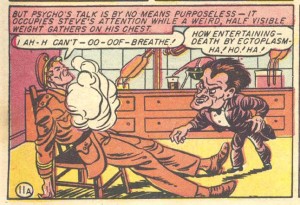
Writes Berlatsky, “If this is a sexualized encounter, any intimacy between the two men is routed not through a woman…but rather through femininity. Male lust is transformed into female sensuality…the result is an uncanny vision of men having lesbian sex.”
The sexualization of Marston’s comic reaches its limit through the symbolism of Wonder Woman’s lasso – “a vagina as surely as James Bond’s gun is a penis.” Berlatsky presents the lasso-vagina as an object that “immobilizes and compels responses from male bodies – and not incidentally from female ones as well.” His view that Marston’s comic queers gender categories rather than simply inverts the male/female binary is contentious enough. The fundamental question, however, is why Berlatsky insists on investing acts and instruments of menace with sexual/genital symbolism. We have penises as weapons, vaginas as traps (e.g. a lasso that overrides free will to compel obedience), attempted murder as lesbian sex – all readings that present sex through terror and violence (physical and psychological). Not only does this reading seem contrary to Marston’s agenda of celebrating women as the superior gender, it reinforces an association between sex and violence that damages rather than opens our cultural psyche. Hasn’t sexuality suffered enough from Freudian shame…and finally earned its liberation (its happy ending, as it were)?
Altogether, the Freudian interpretations, the tangential references to everything from James Bond to Solaris, the artificial “decoding” of comic book panels – all of these amount to pulling the rug out from Berlatsky’s project. His book demonstrates what Susan Sontag warned about: “By reducing the work of art to its content and then interpreting that, one tames the work of art. Interpretation makes art manageable, comformable.” On reading a few issues of Marston’s original comics, which struck me as par for the primitive times in terms of writing and art quality, I found its undeniable pulp adventure exhilaration reduced by Berlatsky’s method of replacing the literal with the implausibly symbolic.
Ironically, the most instructive chapter by far (the conclusion, “A Future Without Wonder Woman”) is the one that deviates from his agenda of privileging “theory over comics’ specific history.” By strolling through the changes Marston’s legacy has been subjected to in the hands of successive comic writers and artists, Berlatsky clearly demonstrates how Wonder Woman’s singular feminism has been altered, even to the point of enacting the very ideals Marston argued against. Those nuggets of insight into Marston’s rationale, strewn across the book, all come together to reveal Berlatsky at his most effective in advocating on behalf of the original Wonder Woman; not so much its meaning, but its value. He identifies, quite justifiably, the fault lines that could be exploited to subvert the model of white male power fantasies in today’s comic book culture. This chapter alone is enough to declare Berlatsky’s success in drawing attention to the underappreciated Marston. Most importantly, he succeeds in challenging us to engage Wonder Woman with the same willingness to subvert mainstream thinking that Marston exhibited.
So what of Zack Snyder’s take on Wonder Woman? Will it revolve around two manly-men divided, not by a v for versus, but by a v for vulva? While I’m keeping an open mind, I’m not especially encouraged given his vision of iconic male superheroes. Snyder’s version of Batman, insofar as it draws on Frank Miller’s crypto-fascist interpretation of the character, isn’t inspiring. Nor is his sour Superman from Man of Steel – I’ll take J. Michael Straczinski’s Earth One version. If there’s any hope that Wonder Woman today can reconnect with the ideals that gave birth to her, it may be in Grant Morrison’s forthcoming Earth One graphic novel. As he told Hero Complex about his project, “I started with the first principles, which is what I usually do, and go back to the original creators’ intentions….and although I don’t necessarily agree with Marston’s particular view on the world, or Marston’s particular kinks, I wanted to do something that at least lived up to those ideals.” We’ll see.
Frédérik is the Page’s Resident Art Critic and Assistant Editor. He can be reached at fsisa@thefrontpageonline.com.


